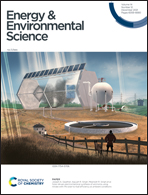An over 10% module efficiency obtained using non-Bi2Te3 thermoelectric materials for recovering heat of <600 K†
Abstract
Thermoelectric technology offers the unique advantages of being completely solid-state, silent and emission-free for waste-heat recovery applications. Despite this, existing thermoelectric modules, particularly for recovering low-grade but abundant heat of <600 K, have been limited to Bi2Te3 alloys in both p- and n-type conductors for more than half a century. These Bi2Te3-based modules have remained stagnant with a poor efficiency of <7%. Recently developed p-GeTe and n-Mg3Sb2 have shown great potential in competing with the performance of historical Bi2Te3 thermoelectrics, realizing efficient thermoelectric applications while creatively using non-Bi2Te3 materials. In this work, we demonstrated a module-level conversion efficiency of >10% with a heat source temperature of <600 K using p-GeTe/n-Mg3SbBi thermoelectrics. This was enabled by the extraordinary thermoelectric performance of both the p- and n-type materials. In addition, a design of Ag/SnTe/GeTe and Ni/Fe/Mg3SbBi contacts enabled an efficient prevention of chemical diffusion as well as low interfacial resistivity. This work illustrates that non-Bi2Te3 thermoelectrics have the potential to realize an even higher efficiency in recovering abundant low-grade (<600 K) waste heat.



 Please wait while we load your content...
Please wait while we load your content...